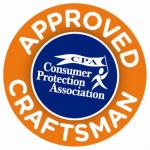CPA - The Consumer Protection Association
The Consumer Protection Association are a top uk consumer protection agency whom have been supporting customers and installation companies such as Rococo for over 20 years.
Regulated by the Financial Conduct Authority (FCA), CPA offer a range of products which protect the consumer when purchasing home improvements, delivering complete peace of mind from the beginning to the end of the project and beyond.
As a CPA member, Rococo have been fully vetted for our professional competence and integrity. This membership reflects that we are highly skilled and display the best trading practices and standards and as such offer the following benefits to our customers:
Insurance Back Guatantee
An Insurance Backed Guarantee (IBG) is valuable protection in the unlikely event of an installation company or contractor ceasing to trade. The Consumer Protection Association (CPA) provides its members with an 10 Year Insurance Backed Guarantees for every project. This protects you in the unlikely event that Rococo ceases to trade due to liquidation or bankruptcy. The CPA have this policy underwritten by an authorised insurer
Deposit Protection
The CPA deposit protection scheme is insurance for the deposit you pay to secure the work to be carried out on your home. This insurance covers a deposit of up to 25% of the agreed price or £7,500, whichever is the lesser.
The policy covers you for a period of up to 90 days from the date you pay your deposit. If you have paid a deposit to a company who then ceases to trade due to liquidation, receivership, administration or winding up the business due to bankruptcy, state retirement or death of the principal(s), your deposit is either refunded to you in full, or the work is completed by another company at the balance agreed price.
Consumer Complaints Policy
All CPA member companies have an effective complaints handling system. In the unlikely event that that Rococo are not able to resolve your problem, you can approach the CPA at CPA House, North Bridge Street, Shefford, Beds, SG17 5DQ. They will independently mediate between yourselves and Rococo to effect a resolution to the complaint. Details can be sent by post or by email to info@thecpa.co.Each CPA accredited installer has been vetted to ensure they offer excellent customer service, value for money and quality workmanship.
Alternative Dispute Resolution (ADR)
If your complaint is not able to be resolved by the CPA’s independent mediation activities, then a low-cost independent ADR scheme is available. The consumer may choose to opt for details of this when at least 56 calendar days have elapsed since their complaint was first raised. The CPA will then write to both parties advising of the availability and details of the CPA’s ADR Scheme, operated by the Utilities ADR arm of the Retail Ombudsman.
Glass and Glazing quality assurance
The visual quality of all supplied and installed glazing will be accordance with the Glass and Glazing Federation guidelines (GGF). No allowances will have been made to allow to adhere to any other visual quality guidelines.
Please find details below which outline the visual quality standards outline by the Glass and Glazing Federation.
Visual quality standard for installed insulating glass units constructed from flat transparent glass:
- Transparent glass used in the manufacture of insulating glass units is identical to that used traditionally for single glass and will, therefore, have a similar level of quality.
- Both panes of the sealed unit shall be viewed at right angles to the glass from the room side standing at a distance of not less than 2 metres but for toughened, laminated or coated glasses (not less than a distance of 3 metres) in natural daylight and not in direct sunlight with no visible moisture on the surface of the glass. The area to be viewed is the normal vision area with the exception of a 50mm wide band around the perimeter of the unit.
- Flat transparent glass, including laminated or toughened (tempered) glass, shall be deemed acceptable if the following phenomena are neither obstructive nor bunched: totally enclosed seeds, bubbles or blisters; hairlines or blobs; fine scratches not more than 25mm long, minute embedded particles. Obstructiveness of blemishes shall be judged by looking through the glass, not at it, under lighting conditions as described in 2.
- When thermally toughened glass is viewed by reflection, the effect of the toughening process may be seen under certain lighting conditions. The visibility of surface colouration or patterns does not indicate deterioration in the physical performance of the toughened glass. Because of the nature of the toughening process, distortion will be accentuated when the glass is viewed in reflection or incorporated in insulating glass units.
- Visible double reflection can occur under certain lighting aspect conditions, especially when viewed from an angle. This is an optical phenomenon arising from multiple surface reflections in sealed units.
- The manufacture of flat laminated glass does not usually affect the visual quality of the glass incorporated in insulating glass units. However, the faults generally accepted in Paragraph 3 may be increased in number if several glasses and interlayers are used in the production of laminated glass. When viewed under certain light conditions, insulating glass units incorporating clear or tinted flat laminated glass may show a distortion effect caused by reflection on the multiple surfaces of the components of the laminated glass.
- Brewster’s Fringes – The appearance of the optical phenomenon known as Brewster’s Fringes is not a defect of the glass, and can occur with any glass of high optical and surface quality. This phenomenon is a result of the high quality now being achieved world wide by modern methods of glass manufacture. Brewster’s Fringes occur if wavelengths of light meet up with each other when they are exactly 180° out of phase – an example of the phenomenon known physicists as the interference of light. The effect is similar to, although usually much smaller than, the interference fringes which can sometimes be seen on toughened glass windscreens. Brewster’s Fringes occur when the surfaces of the glass are flat and the two panes of glass are parallel to each other, i.e. when the light transmission properties of the installation are of a very high order. This phenomenon is not a defect of the product, being dependent on the laws of physics and not in the quality of the insulating glass. In fact it arises because modern glass made by the float process in flat, therefore, free of the distortion inherent in sheet glass. The occurrence of Brewster’s Fringes is in its nature rather like (though very much more rare than) the fact that under certain conditions, the observer will see a reflection of himself in any window or door – and no-one could claim that this was a defect of glass.
Note: Patterned Glass
The above criteria do not apply to patterned glass, as due to the method of manufacture, imperfections such as seeds and bubbles are deemed to be acceptable




